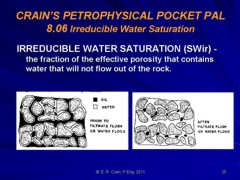|
 Hydrocarbon
Density
Hydrocarbon
Density
Frequently, in cases where gas is indicated from neutron and density
logs, it is advantageous to know the actual value of the hydrocarbon
density and to distinguish gas from light oil. The procedure is
as follows:
 Hydrocarbon Density Calculation
Hydrocarbon Density Calculation
Find
density and neutron log reading corrected for shale.
1: PHIdc = PHID - Vsh * PHIDSH
2: PHInc = PHIN - Vsh * PHINSH
Find
density neutron effective porosity.
3: PHIedn = ((PHIdc ^ 2 + PHInc ^ 2) / 2) ^ 0.5
Find
apparent fluid density from the density response equation.
4: IF PHIedn > 0
5: THEN DENSfla = DENSMA - PHIdc * (DENSMA - DENSW) / PHIedn
6: OTHERWISE DENSfla = 1.0
Find
maximum and minimum hydrocarbon density.
7: IF Sw <= 0.7
8: AND IF Sxo <= 0.85
9: THEN DENShmax = (DENSfla - DENSW * Sw) / (1 - Sw)
10: AND DENShmin = (DENSfla - DENSW * Sxo) / (1 - Sxo)
11: DENShy = (DENShmax + DENShmin) / 2
12: IF Sw > 0.7
13: THEN DENShy = 1.0
14: AND FluidFLAG$ = "W"
15: IF DENShy <= 1.0
16: THEN FluidFLAG$ = "O"
17: IF DENShy < 0.5
18: THEN FluidFLAG$ = "G"
19: AND DENSgas = 0.75 * (DENShmin + 0.14)
Where:
DENSfla = apparent fluid density (gm/cc)
DENSgas = density of gas (gm/cc)
DENShmax = maximum hydrocarbon density (gm/cc)
DENShmin = minimum hydrocarbon density (gm/cc)
DENSMA = matrix density (gm/cc or kg/m3) DENSW = water density
(gm/cc)
PHID = density log reading (fractional)
PHIdc = density log porosity corrected for shale (fractional)
PHIDSH = density log shale value (fractional)
PHIedn = effective porosity from density neutron log (fractional)
PHIN = neutron log reading (fractional)
PHInc = neutron log porosity corrected for shale (fractional)
PHINSH = neutron log shale value (fractional)
Sw = water saturation in un-invaded zone (fractional)
Sxo = water saturation in invaded zone (fractional)
Vsh = volume of shale (fractional)
 COMMENTS:
COMMENTS:
Some analysts prefer to use DENShmin as the final DENShy value,
or may prefer to weigh the minimum and maximum values differently
than shown above. This calculation should not be attempted in
bad hole conditions where density data is suspect.
RECOMMENDED
PARAMETERS:
None.
 NUMERICAL
EXAMPLE:
NUMERICAL
EXAMPLE:
1. Data from Sand C, Classic Example 1.
PHIN = 0.24
PHID = 0.33
DENSMA = 2.650 g/cc
DENSW = 1.00 g/cc
Vsh = 0.0
Sw = 0.50
Sxo = 0.75
PHIdc = 0.33 - 0.0 * 0.03 = 0.33
PHInc = 0.24 - 0.0 * 0.30 = 0.24
PHIedn = ((0.33 ^ 2 + 0.24 ^ 2) / 2) ^ 0.5 = 0.294
DENSfla = 2650 - 0.33 * (2.650 - 1.000) / 0.294 = 0.797 g/cc
DENShmax = (0.797 - 1.000 * 0.50) / (1 - 0.50) = 0.594 g/cc
DENShmin = (0.797 - 1.000 * 0.75) / (1 - 0.75) = 0.188 g/cc
Therefore,
the hydrocarbon density is somewhere between 0.188 and 0.594 g/cc
and the zone is probably gas bearing.
DENShy
= (0.188 + 0.594) / 2 = 0.391 g/cc
Since
DENShy < 0.500 g/cc
DENSgas = 0.75 * (0.391 + 0.140) = 0.398 g/cc
|


